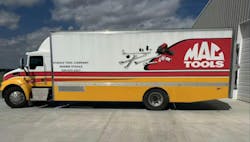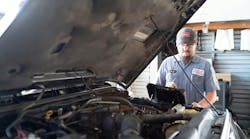Tool trucks serve a variety of purposes. In some cases, they are a mobile showroom, allowing sales teams to sell tools on the go or utilitarian vehicles transporting tools to job sites.
Regardless of how a tool truck is used, keeping it well maintained is critical to ensuring the best possible lifespan from the truck and the components found within it.
For those who operate a tool truck, the following guide will outline the best methods for maintaining a tool truck of any kind.
Periodically clean your toolboxes
Located within the tool truck, on the truck bed, or even as rollaway options, the core of a tool truck is the truck’s storage options. Over time, these toolboxes can become dirty, grimy, and greasy. Periodically cleaning your toolboxes will help protect the storage boxes from damage and ensure that your workspace looks its best.
Depending on the type of toolboxes your truck contains, there are a few different methods for cleaning the boxes.
Cleaning aluminum toolboxes
For aluminum toolboxes, you’ll want to begin by emptying them of their contents. Then, using water, rinse the toolboxes and remove any loose debris or dirt.
Next, to remove grime and grease that’s harder to clean, try one or more of the following aluminum-safe tactics:
- Can of Coke: Pour a can of coke over the section of the toolbox that needs cleaning. Allow the soda to sit for a few minutes, then scrub off. Rinse and polish.
- Aluminum cleaner and brightener: If water and coke don’t do the trick, consider purchasing an aluminum cleaner and brightener. For example, Star Brite is specifically designed to help remove stains and leave your toolbox brighter.
- Aluminum safe degreaser: If your toolbox has grease stains that won’t come off, try using an aluminum safe degreaser. Zep Heavy-Duty is a great product that is easy to find at your local automotive or hardware store.
Cleaning steel toolboxes
If your tool truck has steel toolboxes, your cleaning method won’t differ much from aluminum. Begin by washing the boxes with water, getting rid of dirt and debris. Next, the following steel-safe methods for removing tough grease and grime:
- White Vinegar: Vinegar is a versatile cleaner and can help you remove dirt and grime off your steel toolbox safely. Soak the affected area in white vinegar for 10-15 minutes. Then, scrub the area and rinse with water.
- Club soda: For difficult to remove stains, club soda can be the cure. Pour club soda over the stain and allow it to sit for a few minutes. Then, wipe the soda away and rinse with water.
- Steel safe degreaser: Consider purchasing a steel safe degreaser when a grease stain won’t be lifted with any other means. Similar to aluminum, Zep Heavy-Duty is an excellent degreaser for this purpose.
Follow regular maintenance intervals
Beyond just ensuring that the toolboxes and displays in your truck are well maintained, a vital part of ensuring that your tool truck will continue to operate smoothly over the years is to keep up with regular vehicle maintenance intervals.
These intervals will vary based on the chassis your tool truck was built on, but the following are all common maintenance tasks that should not be put off past the manufacturers recommended intervals:
- Air brake service
- Coolant replacement or top-off
- Differential fluid change
- Oil change
- Power steering fluid flush
- Tire rotation
- Transmission fluid flush
- Transfer case fluid change
Be sure to keep detailed records of all work that is performed on your tool truck. This will help ensure that you do not miss any critical maintenance tasks as the truck’s mileage increases.
Change your driving habits
One overlooked method for maintaining tool trucks — or any customized truck build for that matter — is to change the way you drive. Many poor driving habits can cause a truck to break down more frequently and lead to premature failure of the truck’s mechanical components.
Use the following list of driving do’s and don’ts to help increase the longevity of your tool truck.
- Do accelerate slowly: When the light turns green, don’t punch the gas. Instead, focus on a slow, steady acceleration which is easier on your truck’s transmission.
- Do use engine braking and coasting: Rather than placing a heavy amount of strain on your brakes, use engine braking and coasting to your advantage. This is particularly helpful on steep grades or in heavy traffic. Pay attention to the road and the vehicles ahead of you and slow down well ahead of any full stops.
- Don't ride the bumper: Often, when you are driving, you have a schedule to keep. This can make it frustrating when you are stuck behind slow-moving traffic. However, riding the bumper of the vehicle in front of you is not only dangerous, but it can lead to overuse of your brakes. Instead, leave ample space between you and the vehicle ahead to protect your tool truck’s braking system.
- Don't overload your truck: Transporting tools require the ability to haul heavy amounts of weight. But, be sure that the weight you are adding to your truck is the right amount for the one you own. If you find that you are frequently overloading your tool truck, it might be time to invest in a new build on a larger chassis. Overloading your truck can lead to transmission and/or brake failure.
Create a tool truck for your needs
At Summit Bodyworks, we can assist you in creating a high-quality tool truck to meet any need. Whether you plan to use your tool truck as a mobile showroom or need it to haul your tools to a job site, our team will work with you to design a tool truck that’s built on a high-quality chassis.
Interested in seeing what we can do? Feel free to check out our recent customer builds. For example, we helped design a Matco truck built on a Peterbilt 337 with a 26' body upgraded to PX9 300 horsepower. This tool truck was designed with the best features, including a recessed sunglass display, rollaway shelving, a 90 can beverage cooler, and so much more.
Information provided by Summit Bodyworks.


